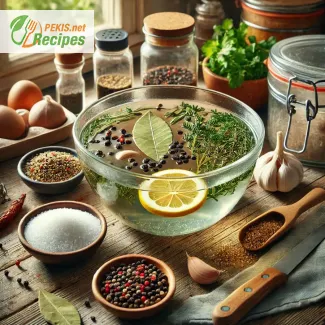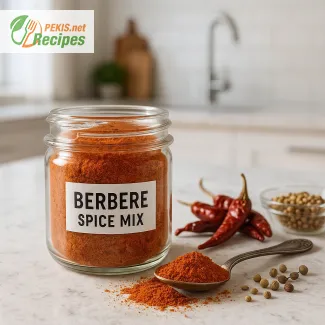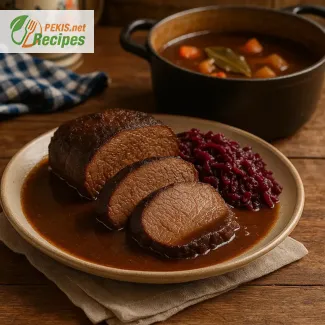
Turkish brine, or “Türk salamura”, is a centuries-old culinary tradition that serves as the backbone of many iconic dishes from the rich tapestry of Turkish cuisine. Renowned for its unique ability to preserve, tenderize, and infuse flavors, Turkish brine is not just a preservation method; it’s a transformative technique that elevates ingredients to new heights of taste and texture.
At its heart, Turkish brine is a simple yet sophisticated combination of salt, water, and often a symphony of aromatic herbs and spices, ranging from earthy cumin and zesty coriander to fragrant dill and warming allspice. This balance between simplicity and complexity has made Turkish brine a staple in both traditional kitchens and modern gastronomy. Its versatility allows it to enhance everything from succulent meats and delicate seafood to crisp vegetables and creamy cheeses.
A Culinary Secret for Tender and Flavorful Dishes
One of the greatest advantages of Turkish brine is its ability to tenderize proteins. The salt content works at a molecular level, breaking down muscle fibers and ensuring that meats and seafood stay juicy and tender during cooking. Whether you’re preparing lamb kebabs, marinated chicken, or flaky white fish, the infusion of flavors during the brining process creates dishes that are not only moist but also bursting with layered, complex tastes.
Vegetables, too, benefit immensely from Turkish brine. Cucumbers, peppers, and cabbages, for example, are transformed into mouthwatering pickles, offering a tangy, savory crunch that pairs beautifully with rich, hearty meals like manti or kebab platters. Similarly, Turkish cheeses like beyaz peynir or kashar are often stored in brine, giving them a distinctively salty and creamy character that enhances their culinary versatility.
Health Benefits and Cultural Significance
Beyond its culinary applications, Turkish brine carries a legacy steeped in cultural traditions and health benefits. The high mineral content of the salt often used in Turkish brine—especially when sourced from regions like the famous Salt Lake (Tuz Gölü)—provides essential electrolytes that aid in hydration and maintaining balance within the body. Furthermore, the preservation methods developed through brining have historically played a crucial role in sustaining communities by extending the shelf life of perishable ingredients.
Turkish brine is also a reflection of community and hospitality, key values in Turkish culture. From pickling vegetables for family feasts to marinating meats for large gatherings, the brining process often brings people together in the shared love of preparing and enjoying bold, flavorful dishes.
Modern Uses and Global Appeal
In today’s kitchens, Turkish brine has transcended borders, finding its place in global gastronomy. Chefs around the world are embracing this ancient technique to enhance their dishes, infusing modern creations with the depth of flavor and aromatic richness that Turkish brine offers. Whether used to prepare oven-roasted meats, artisanal pickles, or even innovative cocktails (like brine-infused martinis), Turkish brine continues to prove its culinary versatility and timeless relevance.
Why You Should Embrace Turkish Brine in Your Cooking
Incorporating Turkish brine into your cooking repertoire unlocks a world of possibilities. This simple yet powerful technique not only enhances the flavor of your dishes but also helps retain their moisture and freshness. Whether you’re a professional chef or a home cook, mastering the art of Turkish brine allows you to create restaurant-quality meals that are sure to impress.
From its humble origins in the bustling bazaars of Istanbul to its role in modern gourmet kitchens, Turkish brine remains an indispensable tool for creating vibrant, flavorful dishes that celebrate the spirit and heritage of Turkish cuisine. Experience the magic of Turkish brine, and let it transform your meals into unforgettable culinary masterpieces.
This timeless method of preservation and flavor enhancement is more than just a technique—it’s a journey into the heart of Turkish culinary tradition, where every dish tells a story, and every bite is a celebration.
- Preparation Time: 5 minutes
Gather all ingredients and ensure the water is at room temperature or slightly warm (not boiling). - Mixing the Brine: 5 minutes
In a large bowl or container, dissolve the salt and sugar in the water. Stir until fully dissolved. - Infusing Aromatics: 10 minutes
Add the peppercorns, bay leaves, thyme, and garlic to the brine. For a citrusy note, include the lemon slices. Stir gently to distribute the flavors evenly. - Cooling and Resting: 15 minutes
If the water was warmed, allow the brine to cool to room temperature before use. This ensures it doesn’t cook the food during marination. - Application:
Place your choice of meat, seafood, or vegetables in a non-reactive container (glass, stainless steel, or food-grade plastic). Pour the brine over until fully submerged.- For meats: Brine for 6–12 hours in the refrigerator.
- For seafood: Brine for 1–2 hours.
- For vegetables: Brine for 12–24 hours, depending on the desired flavor intensity.
- Final Steps:
Remove the food from the brine and pat it dry with paper towels. Discard the brine or boil it for a few minutes if you plan to reuse it (e.g., in soups).
Enjoy using this authentic Turkish brine recipe to elevate your meals with traditional flavors and tender textures!
Tips to Enhance and Customize the Turkish Brine Recipe
The Turkish brine recipe, with its simplicity and versatility, is a cornerstone of preserving and marinating ingredients. However, there are numerous ways to adapt and enhance this recipe based on your preferences, dietary requirements, or the specific dishes you’re preparing. Below is a detailed guide with professional tips to help you achieve optimal results and tailor the brine to meet your needs.
1. Adjusting the Salt Content for Different Applications
- For Delicate Proteins: If you are brining seafood, poultry, or thin cuts of meat, reduce the salt content to 30 g per liter (2 tbsp / 1.2 oz) to prevent overpowering the flavor or causing the texture to become mushy.
- For Robust Meats: When preparing cuts like lamb shanks, beef, or pork, stick to the original ratio of 50 g per liter (3 tbsp / 1.8 oz) or increase slightly for a bolder taste.
Pro Tip: To reduce sodium intake, replace part of the salt with potassium chloride, which provides a similar brining effect without the health risks associated with high sodium levels.
2. Infusing Unique Flavor Profiles with Spices and Herbs
- Traditional Variations: While thyme and bay leaves are classics, consider adding regional spices like:
- Sumac: For a tangy, lemon-like flavor.
- Aleppo Pepper: To introduce mild heat with fruity undertones.
- Fenugreek Seeds: For an earthy, slightly sweet aroma.
- Modern Twists: Experiment with global flavors by incorporating spices such as smoked paprika, star anise, or ginger slices for an innovative touch.
Pro Tip: Lightly toast whole spices before adding them to the brine. This step enhances their aromatic properties and creates a richer flavor profile.
3. Experimenting with Sweetness Levels
- The 10 g of sugar in the original recipe can be adjusted based on your needs:
- Increase to 20 g (1.5 tbsp / 0.7 oz) for a sweeter profile, ideal for brining pork or chicken wings.
- Use natural sweeteners like honey, maple syrup, or agave nectar for additional complexity.
Pro Tip: If avoiding sugar altogether, substitute it with stevia or erythritol to maintain sweetness without affecting the brine’s properties.
4. Adding Acid for Tenderizing and Flavor
- Citrus Additions: The lemon slices in the original recipe can be replaced or combined with:
- Orange Slices: For a sweeter, fruitier brine.
- Lime Slices: For sharper, more zesty notes.
- Vinegar Options: Replace 50 ml (3 tbsp) of water with apple cider vinegar, white vinegar, or rice vinegar to enhance the tenderizing effect and add tanginess.
Pro Tip: Be cautious with acid in brines for seafood or poultry. Too much acidity can "cook" the protein, leading to a mushy texture.
5. Temperature Control for Optimal Results
- Always ensure the brine is at room temperature or colder before immersing the food. Warm or hot brine can partially cook the protein, especially seafood, leading to uneven texture.
- Refrigerate the brine for at least 15 minutes after mixing to ensure it is cool and safe for use.
6. Timing Adjustments for Different Ingredients
- Vegetables: Harder vegetables like carrots or cauliflower benefit from 24–48 hours of brining, while softer vegetables like cucumbers require only 12–24 hours.
- Meats: Adjust marination times based on thickness. For example, chicken breasts need 6–8 hours, while a whole chicken requires 12–24 hours.
- Seafood: Limit brining to 1–2 hours to preserve the delicate structure.
Pro Tip: Over-brining can lead to overly salty or mushy results. Always monitor marination times closely.
7. Creating a Gluten-Free and Allergen-Safe Brine
- This recipe is naturally gluten-free and free of common allergens. To ensure complete safety:
- Use certified gluten-free salt to avoid cross-contamination.
- Avoid adding commercial spice blends, which may contain hidden allergens. Opt for single-origin, unprocessed spices.
Pro Tip: If preparing the brine for someone with specific allergies, always check for ingredient certifications and use sterilized equipment.
8. Incorporating Nutrient-Rich Ingredients
- Boost the nutritional value of your brine by incorporating ingredients with health benefits:
- Turmeric: A powerful anti-inflammatory and antioxidant, turmeric adds a golden hue and earthy flavor.
- Ginger: Enhances digestion and adds a warming, spicy note.
- Fresh Herbs: Parsley, dill, or cilantro introduce fresh, bright flavors and additional vitamins like Vitamin C and K.
9. Sustainable Practices for Reusing Brine
- Once used, brine can often be repurposed:
- For Soups and Stews: Boil the leftover brine to kill bacteria, then use it as a flavorful base.
- For Pickling: Add fresh vegetables to the strained brine for a quick pickle.
Pro Tip: Do not reuse brine for raw proteins without boiling, as it may harbor harmful bacteria.
10. Elevating Presentation and Final Flavor
- After brining, rinse and pat the food dry to remove excess salt, ensuring a balanced flavor.
- For added texture and flavor, rub the brined food with olive oil, spices, or a glaze before cooking.
- Use garnishes like fresh lemon zest, chopped herbs, or a sprinkle of flaky salt for a visually appealing finish.
Nutritional Impact of Enhancements
By incorporating nutrient-dense ingredients, your brine can also serve as a source of health benefits:
- Vitamin C from Citrus: Boosts immunity and aids collagen production.
- Polyphenols from Herbs and Spices: Reduce inflammation and support heart health.
- Electrolytes from Salt: Help maintain hydration and electrolyte balance.
The Turkish brine recipe is a culinary canvas, allowing you to explore endless possibilities while enhancing its functionality and flavor. Whether you’re aiming for bold, traditional tastes or modern, inventive profiles, these tips will ensure your brine not only meets but exceeds your expectations. By understanding the science behind brining and experimenting with variations, you can elevate your dishes to new heights, creating meals that are flavorful, tender, and unforgettable.
- Contains no allergens or gluten in its original form.
- Substitution Tips:
- For reduced sodium, replace part of the salt with a low-sodium alternative.
- For sugar-free brine, use a sweetener such as stevia or omit the sugar altogether.
- Potassium: 10 mg (supports heart health and muscle function)
- Calcium: 5 mg (strengthens bones and teeth)
- Magnesium: 3 mg (aids muscle relaxation and energy production)
- Iron: 0.1 mg (essential for oxygen transport in the blood)
- Garlic: Contains allicin, which reduces inflammation and boosts immunity.
- Thyme: Rich in thymol, an antioxidant that supports respiratory health.
- Bay Leaves: Provide polyphenols, known for reducing oxidative stress.
Antioxidants in the brine help preserve food while adding health-enhancing properties to the marinated dishes.





